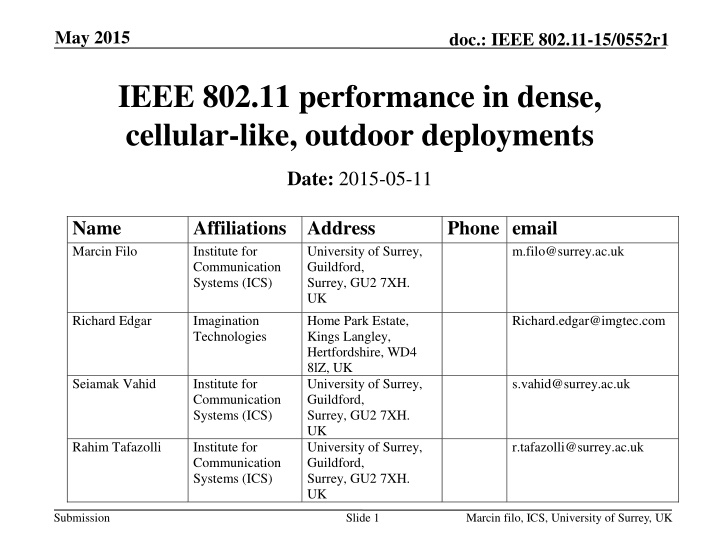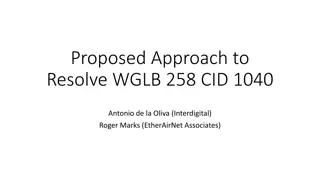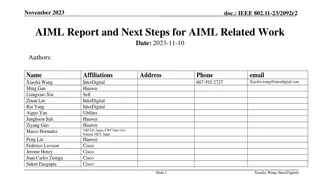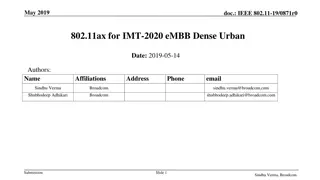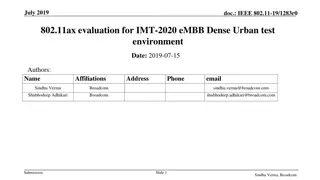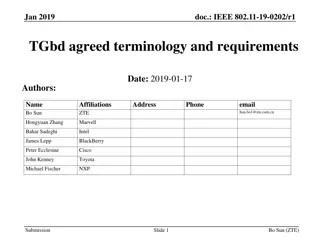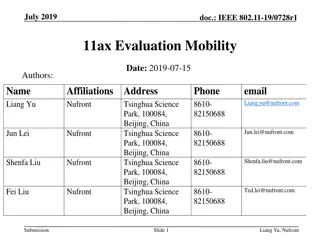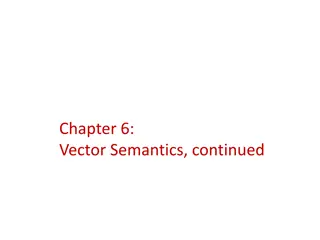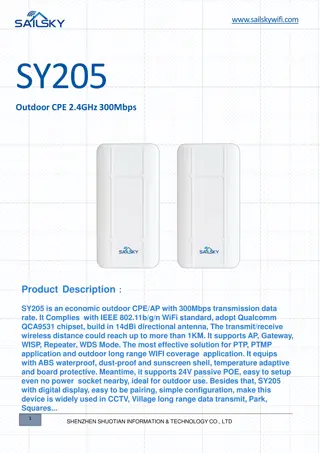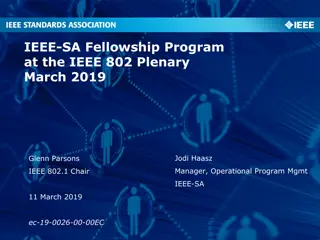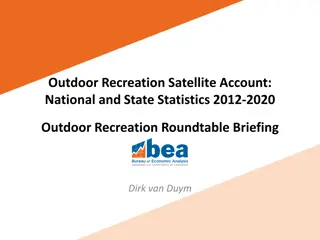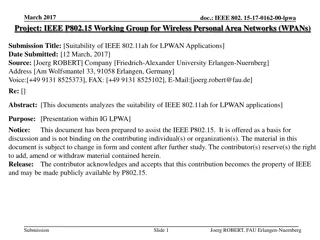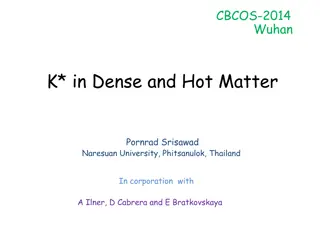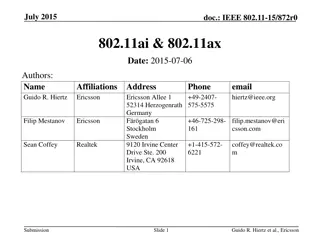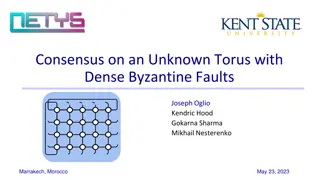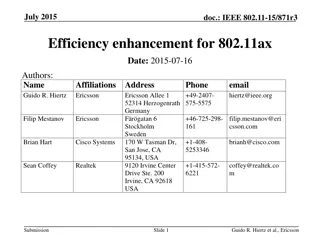IEEE 802.11 Performance in Dense Outdoor Deployments
Investigating the performance of IEEE 802.11 in dense, cellular-like outdoor deployments. Issues related to operation in such environments are highlighted, aiming to identify main bottlenecks. System-level simulations with realistic channel models and wrap-around are utilized to determine performance and address challenges in outdoor wireless channels.
Download Presentation

Please find below an Image/Link to download the presentation.
The content on the website is provided AS IS for your information and personal use only. It may not be sold, licensed, or shared on other websites without obtaining consent from the author.If you encounter any issues during the download, it is possible that the publisher has removed the file from their server.
You are allowed to download the files provided on this website for personal or commercial use, subject to the condition that they are used lawfully. All files are the property of their respective owners.
The content on the website is provided AS IS for your information and personal use only. It may not be sold, licensed, or shared on other websites without obtaining consent from the author.
E N D
Presentation Transcript
May 2015 doc.: IEEE 802.11-15/0552r1 IEEE 802.11 performance in dense, cellular-like, outdoor deployments Date: 2015-05-11 Name Marcin Filo Affiliations Address Institute for Communication Systems (ICS) Phone email University of Surrey, Guildford, Surrey, GU2 7XH. UK m.filo@surrey.ac.uk Richard Edgar Imagination Technologies Home Park Estate, Kings Langley, Hertfordshire, WD4 8lZ, UK University of Surrey, Guildford, Surrey, GU2 7XH. UK University of Surrey, Guildford, Surrey, GU2 7XH. UK Richard.edgar@imgtec.com Seiamak Vahid Institute for Communication Systems (ICS) Institute for Communication Systems (ICS) s.vahid@surrey.ac.uk Rahim Tafazolli r.tafazolli@surrey.ac.uk Submission Slide 1 Marcin filo, ICS, University of Surrey, UK
May 2015 doc.: IEEE 802.11-15/0552r1 Abstract Performance of IEEE 802.11 in dense, out-door, cellular- like deployments is investigated and several issues related to IEEE 802.11 operation in such environments are highlighted. Submission Slide 2 Marcin filo, ICS, University of Surrey, UK
May 2015 doc.: IEEE 802.11-15/0552r1 Overview of the study Aim: Determining performance of IEEE 802.11 in case of dense, out-door, cellular-like deployments and identifying main bottlenecks for such scenarios Motivation: Most of existing simulation studies are conducted for small scenarios and neglect different aspects of an out-door wireless channel Approach: System level simulations with realistic channel models and wrap-around Submission Slide 3 Marcin filo, ICS, University of Surrey, UK
May 2015 doc.: IEEE 802.11-15/0552r1 Simulation tool overview Support of IEEE 802.11a/b/g standards Based on extended NS-3 Wifi module Ongoing validation of IEEE 802.11n implementation Ongoing implementation of IEEE 802.11ac Realistic channel models used for outdoor scenarios Different path-loss models for STA-AP, AP-AP and STA-STA links (based on modified ITU-R M.2135 UMi pathloss model [1], [3],[4]) LOS probability models for STA-AP, AP-AP, and STA-STA links (based on ITU- R M.2135 and 3GPP models [1], [5]) LOS correlation model (based on the modified 3GPP proposal for relay site planning [2]) Shadow fading correlation between arbitrary pairs of links (based on the concept of spatial maps [6], [7]) Ongoing validation of fast fading implementation (based on ITU-R M.2135 and 3GPP models [1], [5]) Submission Slide 4 Marcin filo, ICS, University of Surrey, UK
May 2015 doc.: IEEE 802.11-15/0552r1 Simulation tool overview Wrap-around to minimize border effects Variable number of rings to enable simulation of different cell overlaps (e.g. 24 rings for Inter-site distance [ISD] of 12.5m) Support for hexagonal (i.e. regular) as well as random (i.e. irregular) network layouts Support for RX power calculation and user mobility 4 4 4 4 3 4 4 3 3 4 4 3 2 4 3 3 2 2 3 4 2 1 4 2 3 1 1 3 4 2 2 4 3 1 1 3 4 2 2 1 4 3 2 2 3 3 4 4 3 2 4 3 3 4 4 3 4 4 4 4 Negligible interference Submission Slide 5 Marcin filo, ICS, University of Surrey, UK
May 2015 doc.: IEEE 802.11-15/0552r1 Main simulation parameter settings Main simulation parameters Main simulation parameters Parameter IEEE 802.11 standard RTS/CTS Beacon period Value Parameter Value IEEE 802.11g (DSSS switched off) Off 100ms Adaptive Auto Rate Fallback (AARF) / No Rate Adaptation (54Mbps/24Mbps) 15.0 dBm, 7.0dBm / 18.0.dBm, 10.0 dBm -85.0 dBm / -90.0 dBm (RA scenarios) -74.0 dBm / -79.0 dBm (No RA scenarios) 7 dB / 4 dB Omni-directional Irregular (Random) / Regular (Hexagonal) grid Yes (variable number of rings) 1.5m / 10 m Random uniform distribution ITU-R UMi based model sigma = 3dB (LOS) / 4dB (NLOS), decorr = 10m (LOS) / 13m (NLOS), correlation between arbitrary pairs of links Not considered Not considered Full buffer (saturated model) Elastic (TCP New Reno), Non-elastic (UDP) 1500 bytes (Application layer packet size: 1424 bytes) Network layout Wrap-around STA/AP height STA distribution Path loss model Rate adaptation algorithm STA/AP Transmit power STA/AP Rx sensitivity Shadow fading model STA/AP Noise Figure STA/AP Antenna type Fast fading model Mobility Traffic model STA/AP Antenna Gain -1.5 dBi / 2.0 dBi Number of orthogonal channels Carrier frequency Carrier bandwidth 1 Traffic type 2.4 GHz 20.0 MHz Packet size (size of the packet transmitted on the air interface, i.e. with MAC, IP and TCP overheads) Submission Slide 6 Marcin filo, ICS, University of Surrey, UK
May 2015 doc.: IEEE 802.11-15/0552r1 Impact of AP density on the network throughput (TCP and UDP traffic) Densification of APs can lead to interference & high collision rates (with no further increases in throughput passed the peak capacity) Peak capacity varies depending on the power allocation and AP density Rate Adaptation significantly degrades performance in case of dense deployment TCP congestion control leading to lower throughputs Saturation density Saturation density [Mbps] [Mbps] 100% DL (AP->STA) traffic 100% DL (AP->STA) traffic Data rate controlled by RA rather than TCP TCP Congestion control leading to lower network throughput Submission Slide 7 Marcin filo, ICS, University of Surrey, UK
May 2015 doc.: IEEE 802.11-15/0552r1 Impact of STA density on the network throughput (TCP and UDP traffic) STA density affects the network capacity and fairness (in case of TCP traffic) Saturation due to high contention and collisions Channel dominated by users located in the close proximity to APs leading to unfairness (with TCP) [Mbps] 100% DL (AP->STA) traffic 100% DL (AP->STA) traffic Submission Slide 8 Marcin filo, ICS, University of Surrey, UK
May 2015 doc.: IEEE 802.11-15/0552r1 Impact of traffic asymmetry on the network throughput UL traffic significantly increases level of contention, leading to more collisions and lower throughputs Peak capacity varies depending on the power allocation and AP density Rate adaptation significantly degrades performance in case of dense deployments 100% DL (AP->STA) traffic 50% DL (AP->STA) + 50% UL (STA->AP) traffic Submission Slide 9 Marcin filo, ICS, University of Surrey, UK 9 ISD = Inter-site distance
May 2015 doc.: IEEE 802.11-15/0552r1 Impact of AP-density on overheads Overheads decrease with AP density (better channel quality) Overheads related to background scanning by STAs operating on different channels (not included) and active scanning of unassociated STAs (not included) will significantly increase the overheads, particularly at lower ISDs Probes + Association req./rsp. Re-transmissions + 100% DL (AP->STA) traffic 50% DL (AP->STA) + 50% UL (STA->AP) traffic Submission Slide 10 Marcin filo, ICS, University of Surrey, UK
May 2015 doc.: IEEE 802.11-15/0552r1 Impact of STA-density on overheads Overheads increase with STA density Overheads related to background scanning by STAs operating on different channels (not included) and active scanning of unassociated STAs (not included) will significantly increase the overheads, particularly at lower ISDs 100% DL (AP->STA) traffic 50% DL (AP->STA) + 50% UL (STA->AP) traffic Submission Slide 11 Marcin filo, ICS, University of Surrey, UK
May 2015 Impact of CCA on the system performance doc.: IEEE 802.11-15/0552r1 CCA threshold settings significantly affect system performance Conservative CCA : single AP transmission may block a significant portion of network (APs have higher probability of being in LOS with other APs and STAs thus a single AP may silence a considerable part of network) Aggressive CCA : higher packet loss (and thus lower throughout) for STAs with poor channel conditions/edge 100% DL (AP->STA) traffic 100% DL (AP->STA) traffic Submission Slide 12 Marcin filo, ICS, University of Surrey, UK
May 2015 Impact of the network deployment strategy on the network throughput Regular (i.e. hex-grid) AP deployment and Irregular (i.e. random) AP deployment exhibit similar performance (under M.2135 modified channel model) Results from simple (exponent-only) channel models can be misleading And show significant difference between performance of regular (i.e. hex-grid) and irregular (i.e. random) deployments (not shown here) doc.: IEEE 802.11-15/0552r1 [Mbps] 100% DL (AP->STA) traffic 100% DL (AP->STA) traffic Submission Slide 13 Marcin filo, ICS, University of Surrey, UK
May 2015 doc.: IEEE 802.11-15/0552r1 Summary Performance of dense IEEE 802.11 networks can vary significantly depending on a number of parameters which may not always be dynamically tunable Tuning parameters on the STA side problematic Potential backward compatibility issues caused by different parameter settings across the network Unfairness issues in case of TCP traffic and the negative impact of rate adaptation Only STAs with good channel conditions transmit Due to frequent collisions, majority of stations use low transmission rates Importance of decreasing overheads Retransmissions and beacons identified as a main source of overhead Background scanning and active scanning can further increase (significantly) the overheads, particularly at lower ISDs Importance of proper CCA threshold setting A single transmission by an AP can block significant portion of network (going into back-off) if threshold is set conservatively So called aggressive CCA on the other hand can have a negative impact on performance of cell edge STAs Complexity of IEEE 802.11 optimization CSMA based IEEE 802.11 MAC protocol requires different level of fine tuning in order to cope with problems related to dense deployments potential source of unwanted signaling overhead IEEE 802.11 MAC optimisation is a complex task as it is environment dependent Submission Slide 14 Marcin filo, ICS, University of Surrey, UK
May 2015 doc.: IEEE 802.11-15/0552r1 Recommendations Prevent waste of air time Dynamic/adaptive carrier sensing threshold settings & beaconing (currently APs beaconing consume a lot of spectrum) Need higher data rates for control and management traffic Need proven rate-control (taking account of radio conditions etc.), or setting of requirements on rate adaptation algorithms Reduce overheads due to probe exchanges Overheads related to background scanning by STAs operating on different channels and active scanning of unassociated STAs significantly increase the overheads, particularly at lower ISDs Jointly optimize key system parameters for best performance Many adaptations/techniques have been applied in isolation with aim of improving performance in dense scenarios, but majority suffer from fairness issues. The work in [8] represents an attempt (considering only TX power & CS adaptation) to address fairness issues with noticeable improvements reported. As part of ongoing research, we are developing similar mechanisms but are taking into account a combination of key parameters such as: TX power, TXOP, Phy/MAC aggregation, dynamic CCA and CS thresholds.. Use of directional antennas at APs to compensate for the problem of a single AP transmission silencing the network When mounted at higher elevations, APs have higher probability of being in LOS with other APs and STAs associated with the other AP Submission Slide 15 Marcin filo, ICS, University of Surrey, UK
May 2015 doc.: IEEE 802.11-15/0552r1 References [1] Report ITU-R M.2135-1 (12/2009) Guidelines for evaluation of radio interface technologies for IMT Advanced [2] 3GPP R1-093486: Impact of relay site planning on LOS probability of the backhaul link, RAN1 #58, Ericsson, ST-Ericsson, Aug 2009 [3] IEEE 802.11-13/0756 Channel Model (Broadcom) [4] Report ITU-R M.2146 (05/2009) Coexistence between IMT-2000 CDMA-DS and IMT-2000 OFDMA-TDD-WMAN in the 2 500-2 690 MHz band operating in adjacent bands in the same area [5] 3GPP TR 36.814 v9.0.0 (03/2010) [6] Bijan Golkar, Resource Allocation in Autonomous Cellular Networks , University of Toronto, 2013 [7] S. Helmle, M. Dehm, M. Kuhn, D. Lieckfeldt, D. Pesch, A resource efficient model of spatially correlated shadowing in semi-mobile ad-hoc network simulations , UKSim2013, April 2013 [8] Imad Jamil, et al., Preserving Fairness in Super Dense WLANs , WCNC, 2015. Submission Slide 16 Marcin filo, ICS, University of Surrey, UK
May 2015 doc.: IEEE 802.11-15/0552r1 Backup slides Submission Slide 17 Marcin filo, ICS, University of Surrey, UK
May 2015 doc.: IEEE 802.11-15/0552r1 Simulation parameter settings Main simulation parameters Parameter Value Other IEEE 802.11 related parameters IEEE 802.11 standard IEEE 802.11g (DSSS switched off) Parameter Value Network layout Random / Hexagonal grid Beacon period 100ms Wrap-around Yes (variable number of rings) STA/AP density Variable / Variable Probe timeout /Number of probe requests send per scanned channel 50ms / 2 STA/AP height 1.5m / 10 m STA distribution Random uniform distribution Scanning period (unassociated state only) 15s Path loss model ITU-R UMi based model sigma = 3dB (LOS) / 4dB (NLOS), decorr = 10m (LOS) / 13m (NLOS), correlation between arbitrary pairs of links RTS/CTS Off Shadow fading model Packet fragmentation Off The maximum number of retransmission attempts for a DATA packet Fast fading model Not considered 7 Mobility Not considered Number of orthogonal channels 1 Adaptive Auto Rate Fallback (AARF) / No Rate Adaptation (54Mbps/24Mbps) Carrier frequency 2.4 GHz Carrier bandwidth 20.0 MHz Rate adaptation algorithm STA/AP Transmit power 15.0 dBm, 7.0dBm / 18.0.dBm, 10.0 dBm -85.0 dBm / -90.0 dBm (RA scenarios) -74.0 dBm / -79.0 dBm (No RA scenarios) STA/AP Rx sensitivity MAC layer queue size 1000 packets STA/AP Noise Figure 7 dB / 4 dB Number of beacons which must be consecutively missed by STA before disassociation STA/AP Antenna type Omni-directional 10 STA/AP Antenna Gain -1.5 dBi / 2.0 dBi -82.0 dBm / -87.0 dBm (RA scenarios) -71.0 dBm/ -76.0 dBm (No RA scenarios) STA/AP CCA Mode1 threshold Association Request Timeout / Number of Assoc Req. before entering scanning Strongest server (STAs always associate with APs with the strongest signal) STA-AP allocation rule 0.5s / 3 Traffic model Full buffer (saturated model) Traffic type Elastic (TCP New Reno), Non-elastic (UDP) Transmission failure threshold for AP disassociation procedure 0.99 Packet size (size of the packet transmitted on the air interface, i.e. with MAC, IP and TCP overheads) 1500 bytes (Application layer packet size: 1424 bytes) Submission Slide 18 Marcin filo, ICS, University of Surrey, UK
